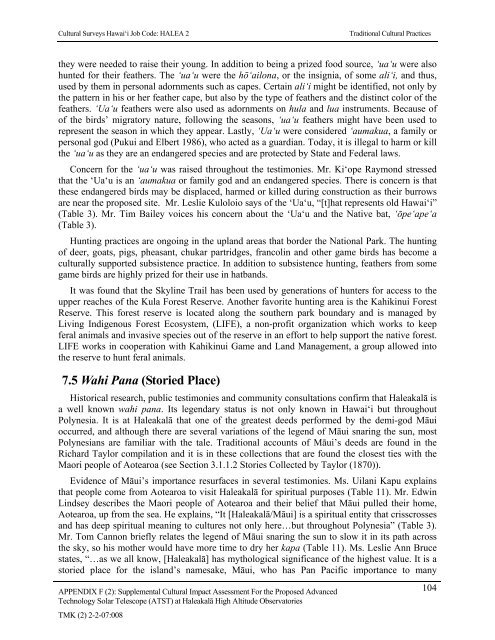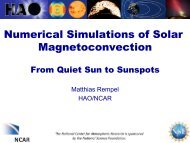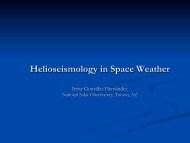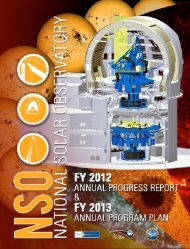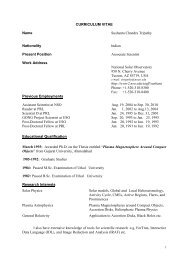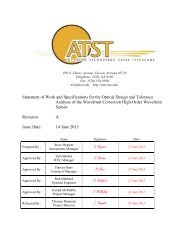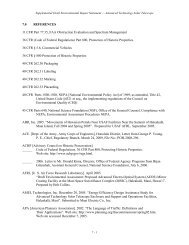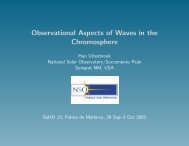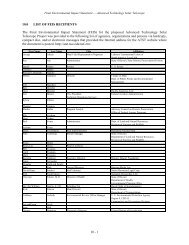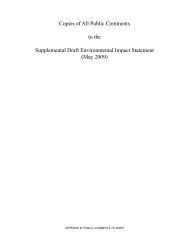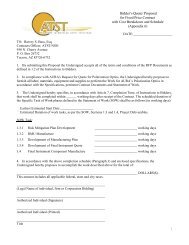F2 - ATST
F2 - ATST
F2 - ATST
Create successful ePaper yourself
Turn your PDF publications into a flip-book with our unique Google optimized e-Paper software.
Cultural Surveys Hawai‘i Job Code: HALEA 2Traditional Cultural Practicesthey were needed to raise their young. In addition to being a prized food source, ‘ua‘u were alsohunted for their feathers. The ‘ua‘u were the hō‘ailona, or the insignia, of some ali‘i, and thus,used by them in personal adornments such as capes. Certain ali‘i might be identified, not only bythe pattern in his or her feather cape, but also by the type of feathers and the distinct color of thefeathers. ‘Ua‘u feathers were also used as adornments on hula and lua instruments. Because ofof the birds’ migratory nature, following the seasons, ‘ua‘u feathers might have been used torepresent the season in which they appear. Lastly, ‘Ua‘u were considered ‘aumakua, a family orpersonal god (Pukui and Elbert 1986), who acted as a guardian. Today, it is illegal to harm or killthe ‘ua‘u as they are an endangered species and are protected by State and Federal laws.Concern for the ‘ua‘u was raised throughout the testimonies. Mr. Ki‘ope Raymond stressedthat the ‘Ua‘u is an ‘aumakua or family god and an endangered species. There is concern is thatthese endangered birds may be displaced, harmed or killed during construction as their burrowsare near the proposed site. Mr. Leslie Kuloloio says of the ‘Ua‘u, “[t]hat represents old Hawai‘i”(Table 3). Mr. Tim Bailey voices his concern about the ‘Ua‘u and the Native bat, ‘ōpe‘ape‘a(Table 3).Hunting practices are ongoing in the upland areas that border the National Park. The huntingof deer, goats, pigs, pheasant, chukar partridges, francolin and other game birds has become aculturally supported subsistence practice. In addition to subsistence hunting, feathers from somegame birds are highly prized for their use in hatbands.It was found that the Skyline Trail has been used by generations of hunters for access to theupper reaches of the Kula Forest Reserve. Another favorite hunting area is the Kahikinui ForestReserve. This forest reserve is located along the southern park boundary and is managed byLiving Indigenous Forest Ecosystem, (LIFE), a non-profit organization which works to keepferal animals and invasive species out of the reserve in an effort to help support the native forest.LIFE works in cooperation with Kahikinui Game and Land Management, a group allowed intothe reserve to hunt feral animals.7.5 Wahi Pana (Storied Place)Historical research, public testimonies and community consultations confirm that Haleakalā isa well known wahi pana. Its legendary status is not only known in Hawai‘i but throughoutPolynesia. It is at Haleakalā that one of the greatest deeds performed by the demi-god Māuioccurred, and although there are several variations of the legend of Māui snaring the sun, mostPolynesians are familiar with the tale. Traditional accounts of Māui’s deeds are found in theRichard Taylor compilation and it is in these collections that are found the closest ties with theMaori people of Aotearoa (see Section 3.1.1.2 Stories Collected by Taylor (1870)).Evidence of Māui’s importance resurfaces in several testimonies. Ms. Uilani Kapu explainsthat people come from Aotearoa to visit Haleakalā for spiritual purposes (Table 11). Mr. EdwinLindsey describes the Maori people of Aotearoa and their belief that Māui pulled their home,Aotearoa, up from the sea. He explains, “It [Haleakalā/Māui] is a spiritual entity that crisscrossesand has deep spiritual meaning to cultures not only here…but throughout Polynesia” (Table 3).Mr. Tom Cannon briefly relates the legend of Māui snaring the sun to slow it in its path acrossthe sky, so his mother would have more time to dry her kapa (Table 11). Ms. Leslie Ann Brucestates, “…as we all know, [Haleakalā] has mythological significance of the highest value. It is astoried place for the island’s namesake, Māui, who has Pan Pacific importance to manyAPPENDIX F (2): Supplemental Cultural Impact Assessment For the Proposed AdvancedTechnology Solar Telescope (<strong>ATST</strong>) at Haleakalā High Altitude ObservatoriesTMK (2) 2-2-07:008104


